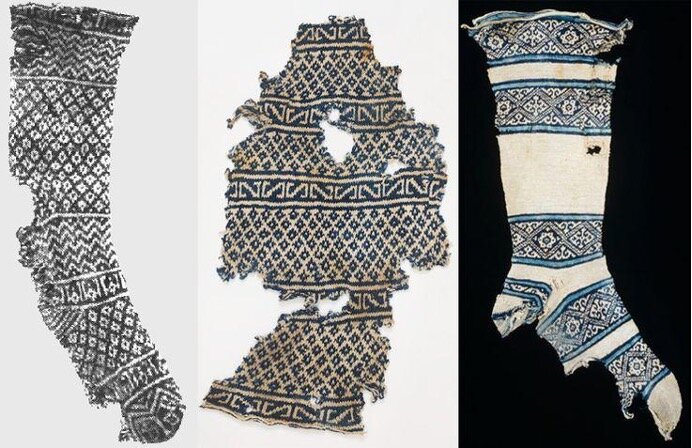History of Knitting
By Sarah Erickson
Knitting has a surprisingly lost history. Routinely, experts find that artifacts previously considered ‘knit fragments’ are actually a precursor of knitting, known as Nalbinding. This discovery of Nalbinding begs the question, where did knitting begin? Currently, it is agreed that the oldest discovered knit sample is a pair of socks from around 1000 CE in Egypt. These are intricate socks made from indigo and white cotton to form geometric patterns often seen in Islamic ceramics. The sock was worked from toe to top while knitting in a round. There is also evidence on either side of insertions for a heel, suggesting that shaping was achieved by changing the size of the needles as the knitting progressed.
While the middle piece shown above is the oldest sample of knitting, it was not the first. Given the detail and technique used in the sock, it indicates that this was not the first knitted item but simply the oldest found fragment. In reality, knitting likely originated around 500 CE. Nalbinding, a knotless fabric creation process, uses a single needle and predates the art of knitting as we know it today. In contrast to Nalbinding, knitting uses a pair of needles to make loops. It is hypothesized that knitting was invented to save time and energy as nalbinding is more complex and requires greater dexterity but creates a smoother and more durable fabric.
Moreover, there have been some disputes about the oldest knitted pieces, as many of the oldest fabrics have now disintegrated. One group with a prominent standing in the history of knitting is the Coptic Christians in Egypt, who were known for their socks dating back 1,700 years, which are now called ‘Coptic socks’. These are knowable for their distinct ankle height and two-toe design meant for sandals. Another significant remnant of knitting’s origin is pieces of socks found in Eastern Syria. Historical samples like this have often been misidentified as knitting due to how similar they can appear in the finished products if made using the Coptic stitch. These were classified as Nalbinding by experts in the craft, but still, represent an essential expansion of knit fabrics. The oldest known textile fragment of Nalbinding, which dates back to 6500 BCE, was found in Nehal Hemar cave, Israel. The first known samples of single-needle knitted clothing include the Coptic socks of Egypt in the 4th century and hats and shawls from the Paracas and Nazca cultures in Peru, which are dated between 300 BCE and 300 CE.
While the origins are unclear, findings routinely point to the Middle East and North Africa as the origin and disseminators of the craft. One example of this is a cache of knitting found in Spain in a tomb sealed in 1275 (when Spain was held by Arabic peoples). Additionally, many of the sock fragments have ‘Allah’ knit into the bands around them. Since then, additional pieces have been found, many of which portray symbols to ward off evil in shades of white and indigo, in stockinette stitch with blessings in Kufic (a decorative Arabic script) knit into them. Given the Dark Ages and the commonality of European illiteracy, these pieces of history point to Arabic artisans as the creators of knitting.
Finally, knitting works right to left, likely reflecting how Arabic and the majority of Semitic languages are written; as opposed to European languages, which are written left to right. This further decreases the likelihood of European origins, supporting the argument of trade and artists rooted in the Middle East and North Africa region.
Archeological findings from Europe show how knitting expanded throughout Europe in the 14th century. Spanish Christian royal families employed Muslim knitters, and their works are of the earliest known knitted items in Europe. They were very skillful and made many different items like cushion covers and gloves. Eventually, knitting became particularly popular in Scandinavia which has become known for warmer hats, gloves, outerwear, and more. This also coincides with a change in the fibers used. Traditionally, most knit materials were cotton or silk, but wool became more common after spreading to Europe thanks to availability and weather.
As shown through its origins in the Middle East and North Africa and widespread expansion beyond the region-- it’s clear that knitting has remained prominent in its evolution throughout time. While there have been innovations in new yarns and patterns, the techniques have remained largely consistent over time and remain central to arts globally.



